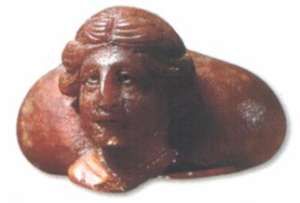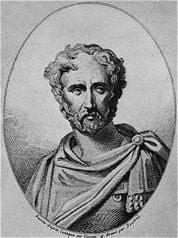Chapters
The Amber Route was a trade route that used to connect Mediterranean countries, including ancient Rome with the Baltic Sea. Baltic amber was known to the Italian Etruscans at the beginning of the last millennium BCE, but the trade of this “gold of the north” was developed on a large scale by the Celts in the last centuries BCE and the early CE, opening amber routes for the Romans. From the 1st to the 3rd century CE it was a symbol of the developing power and influence of the Roman Empire.
The main amber route, along which Roman merchants went for amber, connected the Mediterranean basin with the shores of the Baltic Sea and played a decisive role in trade contacts. It also determined the development of the villages located next to it. Thanks to it, the Romans could indirectly influence the internal politics of northern European peoples. Already at the end of the Neolithic period, amber was a valuable object of exchange. It was called “gold of the north”, “Slavic gold” or “gold of the Baltic Sea” and was widely used in medicine, ornamentation and magic. Ancient writers and scholars (including Homer, Sophocles, Plato, and Pliny the Elder) were also interested in amber.
The amber route, like other historical trade routes, ran along natural “corridors”, that is through the river valleys. The exact course of the route has not been clearly defined. It is believed to have started in Aquileia on the Adriatic, one of the Roman centres of craftsmanship. Initially, the trail led through the Moravian Gate then turned north and through Silesia, eastern Wielkopolska and Kujawy (by ford across the Vistula in Otłoczyna near Toruń) to the Baltic Sea.
It can be assumed that the main thread of the trail, starting from the turn of the 1st and 2nd century CE, ran from Vienna (Vindobona) through Brno, Kłodzko, Wrocław, Kalis (Calisia/Kalisia), Konin (Setidava), Bydgoszcz and Świecie to Gdańsk.
The trail’s heyday took place only after Rome conquered the areas on the central Danube in the 1st century CE. The most abundant trade in amber occurred in the 2nd and 3rd century CE when more and more merchants set out for the amber treasure. Settlements along this route developed, which played a very important role in the economic and social development of Europe.
The long-distance trade along the Amber Road was represented mainly by large Roman companies, dealing mainly with crafts and trade, organizing north-south trade expeditions, and exchanging in the lands of the Transdanubian peoples. Further, merchants, bankers, workshop owners and other entrepreneurs, also minor traders and stallholders accompanied the moving army. They sold food and various everyday items to soldiers, buying spoils of war from them in return.
Wine, Roman banquet dishes and textiles, as well as furs, were traded, and goods were exchanged for goods. The representatives of the local population exchanged amber and other local products with foreign buyers. The tribes of the Baltic zone probably also imported bronze and brass products from the territory of the Empire. The meander motif, which became popular in the basins of the Odra and Vistula rivers, may have come earlier through the Celts. Raw materials and goods purchased by local traders for further exchange with foreign merchants were stored. For example, skins and furs in wooden buildings, while amber itself would not weather out, it was stored in-ground pits. Thus, in exchange for clasps for robes or belt fittings, or fabrics, bags of amber, furs, mainly beaver furs, leather, and wood were exported from the Polish lands back to the south. To maximize profit, merchants ventured far to the North, where probably the prices of Roman products rose, as opposed to local products. Difficulties in obtaining amber and the risk borne by merchant caravans reaching far away dictated a high price for this ore. Sometimes the price of an amber product was higher than the “price” of a slave, it depended on the size of the processed raw material. In the Empire, the Roman authorities supervised travellers’ safety, while in the northern countries, the authorities of tribes and tribal unions took care of it.
The places of long-distance trade where Roman products were delivered from further parts of the Empire and exported to the Transdanubia countries, were urban centres located at the intersections of the main communication routes, right next to legionary camps. In addition to trading places surrounded by halls, there were also postal and customs stations. In these centres, Roman goods were, as it were, distributed, which were destined for the northern peoples.
Roman Amber
The only surviving work of Pliny the Elder is Naturalis historia (“Natural History”), a kind of encyclopedia in 37 books describing, inter alia, cosmology, geography, botany, physiology, and mineralogy. It is a huge mine of knowledge from Roman times. This is how Pliny the Elder begins his story about amber in “Natural History”:
Next in rank among the objects of luxury, we have amber;1 an article which, for the present, however, is in request among women2 only. All these three last-mentioned substances hold the same rank, no doubt, as precious stones
– Pliny the Elder, Natural History, XXXVII.11
From Pliny the Elder, we learn that the Romans dyed amber with goat tallow, conch shell paint or red root, known to us more as the common centuria or the common thistle. Pliny also mentions that ambers rubbed with oil burn brighter and longer than the flax core. Amber was also used to counterfeit expensive transparent stones, especially amethysts.
Of the amber, it is said that the Romans considered white amber the most delicious in terms of smell. It is said that this and the wax-coloured ones did not have a price. On the other hand, yellow amber was considered the most beautiful.
The Romans also used amber in medicine. Children tied them as amulets. According to Kallistratus at all ages, amber works well against madness and problems with urination. Its special variety called “chryselectrum” with a golden colour tied to the neck was supposed to heal fever and other diseases and rubbed with honey and rose oil for ear diseases.
Moreover, Pliny notes:
[…] in Corinthian objects of vertu, it is the copper that recommends them, combined with silver and gold; and in embossed works it is the skill and genius of the artist that is so highly esteemed. We have already said what it is that recommends vessels of murrhine and of crystal; pearls, too, are of use for wearing upon the head, and gems upon the fingers. In the case of all other luxuries, in fact, it is either a spirit of ostentation or some utility that has been discovered in them that pleads so strongly in their behalf; but in that of amber we have solely the consciousness that we are enjoying a luxury, and nothing more.
– Pliny the Elder, Natural History, XXXVII.12
Romans’ quest for amber
The aforementioned Pliny the Elder describes one of the expeditions that took place during the reign of Emperor Nero. Well, Nero sent his subject to provide him with a precious stone. Considering the distance of the Baltic Sea from Rome, his journey probably lasted two months, counting that it exceeded about 30 km a day. The expedition was an official state expedition, not a private commercial initiative. Certainly, the Romans got to know the new lands and the people there better. This is how Pliny describes the expedition of a certain equine:
From Carnuntum in Pannonia, to the coasts of Germany from which the amber is brought, is a distance of about six hundred miles, a fact which has been only very recently ascertained; and there is still living a member of the equestrian order, who was sent thither by Julianus, the manager of the gladiatorial exhibitions for the Emperor Nero, to procure a supply of this article. Traversing the coasts of that country and visiting the various markets there, he brought back amber, in such vast quantities, as to admit of the nets, which are used for protecting the podium against the wild beasts, being studded with amber.
The arms too, the litters, and all the other apparatus, were, on one day, decorated with nothing but amber, a different kind of display being made each day that these spectacles were exhibited. The largest piece of amber that this personage brought to Rome was thirteen pounds in weight.
– Pliny the Elder, Natural History, XXXVII.11
According to the hypotheses of scientists, the expedition started from Carnutum (present north-eastern Austria) and after about 900 km reached the Baltic Sea, the mouth of the Vistula, and even the Sambia Peninsula, known for its large amount of amber. Scientists base their conclusions on the route based on excavations and other sources.










